Norwegian farm structure
It can often be a challenge to find the right place when we try to pinpoint the location of the farm where our ancestors lived. Hopefully, this is a little easier if we know something about the Norwegian farm structure.
Featured photo of Grasreiten at Skeidsvoll by photogr. Josefsen. Used by permission from Romsdalsmuseet.
In this article, I want to look at the structure of the old Norwegian farms. As we look for our ancestors we must go for names and birth dates, but it can be useful to have an overview of the area where they lived.
Garden/Gården – the farm
When we in Norway talk about “en gard” – “a farm” we normally think of one production unit with one household. This is a bit misleading as the old use of the word “Gard” is to describe the original un-divided farm (Holmsen 1979:13). This is also how the word is used in the cadastres (matriklene) Throughout history very many of the original farms (matrikkelgård) were divided into different farm-parts. These farm-parts are in Norwegian called “Bruk”.
I will use the words “original farm” to describe the area that may consist of several production units (bruk). Sometimes these original farms may appear like a little village.
Olav Rekdal gives a good description of this when he tells about the farm Skeidsvoll in the municipality of Vestnes. I choose to use this farm as an example as it does not have all that many divisions. He tells that up until 1654 Skeidsvoll was one undivided farm. Later it was divided into two equal-sized farm-parts (bruk) Innigar(d)en and Utigar(d)en. In 1861 Utigarden was divided (one farm part remained as Utigarden) and the part that was “split off” was called Grasreiten. In 1891 Innigarden was split in two, and the farm part Vollen was created (Rekdal 1973:457). In addition to this, Grasreiten had a cotters place named Rongja.
In sources, we may find people described as living at e.g. Vollen under Skeidsvoll. This means they lived at the farm part Vollen within the area of the original farm Skeidsvoll.
| Skeidsvoll Gard (situation 1891) | |
| Farm parts – Bruk | Cotter’s places – Husmannsplasser |
| Innigarden part no. 1 | Rongja |
| Utigarden part no. 2 | |
| Grasreiten part no. 3 | |
| Vollen part no. 4 |
According to Rekdal’s book, all the people living at the three first farm parts are recorded as living at Skeidsvoll. This means that their “identity information” is ending with Skeidsvoll. E.g. Erik Erikson Skeidsvoll. I wrote, “identity information” to underline that we are not talking about a surname or a family name. The last part of the “id info” that, to us, looks like a surname, is, in fact, the address The people on these three farm-parts were related but were three different production units and households. This was common on different farms. Because of this relationship, you can often find people living on the same farm, but on different farm-parts, with the same name. You might want to have a look at my articles about Norwegian naming and Norwegian renaming traditions where I try to point out the problems this might cause for us genealogists. The people living at the cotter’s place Rongja are also recorded as living at Skeidsvoll (They were not related to the other people at the Skeidsvoll farm). As the last farm-part Vollen (no 4) was established as late as 1891, it seems like the people there used, as a surname, the name of the farm where they originated (Rekdal 1973:467).
Skeidsvoll was/is a fairly small farm. Let us look at the larger Sør-Sylte farm in the same area (Tresfjord, Møre og Romsdal), still helped by Olav Rekdal’s farm and family history book.
| Sør-Sylte Gard (situation ca. 1900) | |
| Farm parts – Bruk | Cotter’s places – Husmannsplasser |
| 1. Lensmannsgarden/Ivergarden |
|
| 2. Olagarden | |
| 3. Markengarden | |
| 4. Martinesgarden |
|
| 5. Syltebøen |
|
| 6. Andersgarden/Umunngarden | |
| 7. Villagarden |
|
| 8. Knutgarden/Heljegarden |
|
| 9. Øvrebøen/Gjere |
|
| 10. Nybøen | |
| 11. Nilsgarden | |
| 12. Syltebakkå | |
The cotter’s places I have listed here may not all have been occupied at the same time. I have already left out four un-named cotter’s places mentioned in early sources, as I suspect they may be some of the same places that are mentioned later with the above listed names.
If we go to the 1801 census and look at Sør-Sylte/Sørsylte, we find 66 persons listed under this farm. Five men are listed as “Huusbonde” which means that they were head of a household. In addition, we find three men listed as “huusmand” which means they were cotters. On the Sør-Sylte farm, we find eight different household/production units living on different farm parts/cotter’s places. We have 66 persons who all may appear in the sources as “first name” – “patronymic” – “Sør-Sylte” (Ref : my article Norwegian naming). Some of these people were related. Others were not, like my forefather Hans Larson. He is one of the cotters listed in this census. He and his wife Guro Olsdatter both came from other parts of Norway.
If we go to the 1900 census, we find at Sør-Sylte 129 persons living in ca. 26 households. I write “circa” as some of these persons are single, undoubtedly lodgers, and one may debate if it is correct to call them “a household”. We can see that some have started to use surnames as there are people recorded with last names that do not originate on the Sør-Sylte farm. Some of the people may have started to use their patronymic as a surname. Still, there is a large number of people at this farm who may be recorded, in the sources, with Sør-Sylte/Sørsylte/Sylte used as a surname. Once again; these people may or may not be related. Surnames as a legal concept were not introduced in Norway until 1923.
Cadastre/Cadaster is a comprehensive register of the real estate that commonly includes details of the ownership, the tenure, the cultivations if rural, and the value of individual parcels of land. (Wikipedia)
The farm numbering system
I feel it would be wrong to talk about the Norwegian farm structure without mentioning the farm numbering system. This system was put in place to clearly identify the different farms and farm parts. As the numbering system has changed over the years, it can sometimes be more confusing than clarifying. I will try to break it down and point out some things to keep in mind.
The cadastre was updated on a regular basis to reflect the changing value of the farms. We will look at some changes that were made to this system,
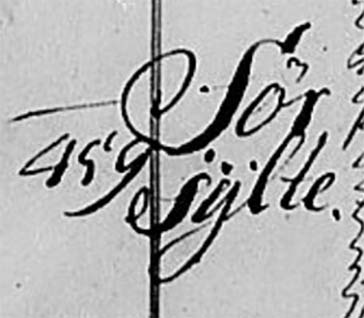 In the early 1700’s they started to identify the original farms by a number (Matrikkelnummer). The number series covered fairly large areas (Holmsen 1979:182). This scan from the 1724 cadastral draft shows Sør-Sylte farm as number 459. In this system, the different farm parts were only identified by the name of the head of the household.
In the early 1700’s they started to identify the original farms by a number (Matrikkelnummer). The number series covered fairly large areas (Holmsen 1979:182). This scan from the 1724 cadastral draft shows Sør-Sylte farm as number 459. In this system, the different farm parts were only identified by the name of the head of the household.
The scan below from the cadastral revision from 1836 (put in effect in 1838) show that the original farms are given new numbers (matrikkelnummer). The first column shows the new number (Sør-Sylte 24) and in the second column, we recognize the number 459 from the 1724 cadastral draft. The original farms were numbered starting with “1” in each “thinglag” (court district). In this new cadastre, the different farm parts are numbered (løpenummer). As I have included the farms before and after Sør-Sylte, we see that the farm starts have a different number series also starting at “1” in the court district. When there were new farm divisions these farm parts got a letter attached to the original number e.g. 73b (Geire 1996:24). If these “number-letter b” farms were divided each part got added a number e.g. 73b1 and 73b2 (Stoa 1993:19)
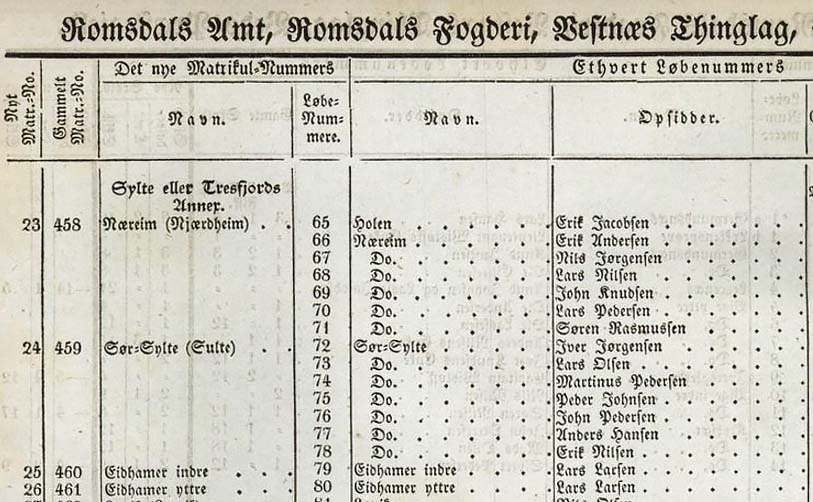
It soon became clear that this numbering system was very confusing and did not serve its purpose. The work on a new cadastral was started in 1863 and put in place in 1886. Here the old “Matrikkelnummer”- cadastre numbers, was renamed “Gårdsnummer” – farm number starting with number 1 in each municipality. The number on the farm parts (løpenummer) was called “Bruksnummer”. In addition, the farm parts were starting with the number 1 under each original farm. (Geire 1996:24)
These are the terms and the numbering system that is still in use today. Each piece of property should be numbered according to this principle. In relation to Norwegian real estate you sometimes find the abbreviation “Gnr./Bnr. 61/137”. This means plot (farm part) number 137 under the original farm number 61.
When trying to pinpoint the location where your ancestors lived you may have a look at the Cadastral from 1886. (GÅRDSMATRIKKELEN FOR 1886). This source is unfortunately only available in Norwegian, but I believe you will be able to use it. What is interesting with this source, is that it lists both the old Cadastral number (Gammelt matrikkelnummer) and the new Farmnumber (Gårdsnummer). We also see that the old numbering of the farm parts (Gammelt løpenr) is replaced by numbers starting with 1 within each farm (Bruksnummer).
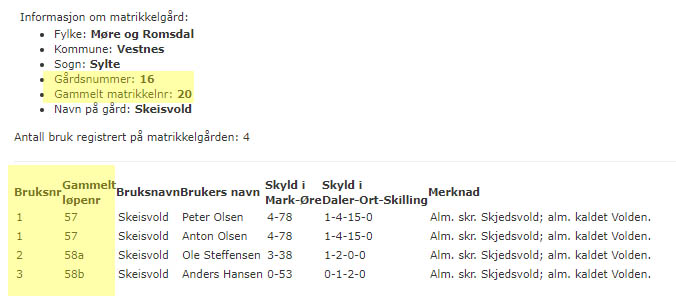
In addition to the changes we have already looked at, there are some other things to keep in mind when looking at the farm structure and farm numbering.
Sometimes the farm numbering may not truly show the extent of the original farm. We find a number of farms that have a prefix to their name. These prefixes are normally adjectives that tell something about how the farms/farm parts are geographically placed in relation to each other. E.g. Ytre (Outer) Eidhammer and Indre (Inner) Eidhammer. My family should actually be named “Indre Eidhammer”. There are many other adjectives in use e.g Søndre/Nordre – Southern/Northern. Øvste/Nedste – Upper/Lower and also Store/Lille – Big/Small These distinctions may be relevant for us as the people may be referred to by only the main part of the farm name. My family has since the 1880s used Eidhammer as a family name and so have people from the farm “Ytre Eidhammer”.
Some farm parts may “disappear” from maps and later records as these are sold/inherited and included in neighboring farm parts.
In parts of the country, the farms were not numbered in the earliest cadastres. Through the different revisions of the cadastre, some of the original farms may have been redefined as farm parts of a different farm. (Holmsen 1979:202-203).
If two municipalities unite, the farm numbers of one of the municipalities have to be changed to fit with the numbering in the other municipality. If the geographical boundaries are adjusted, farms may end up in a new municipality and thus get a new number.
This article grew in size while I worked on it. I hope I have been able to explain the Norwegian farm structure in a comprehensible way. I also hope that this article shows how knowledge about this can be useful to us genealogists. If nothing else, I learned a lot from writing it 🙂
Please don’t hesitate to comment or contact me if you find something that needs clarification, or you see that something is missing or wrong.
Sources:
Geire, Elin R.: Generasjonsskifte eller transaksjon? : om handlingsmønstre og normer når jord skiftet eier i Ullensaker på 1800-tallet Oslo : Tingbokprosjektet, 1996
Holmsen, Andreas: Gård, skatt og matrikkel Oslo : Universitetsforlaget, 1979
Rekdal Olav: Gards- og slektshistorie for Vestnes – Tresfjord. 1: “Tresfjord” Vestnes: Vestnes kommune, 1973

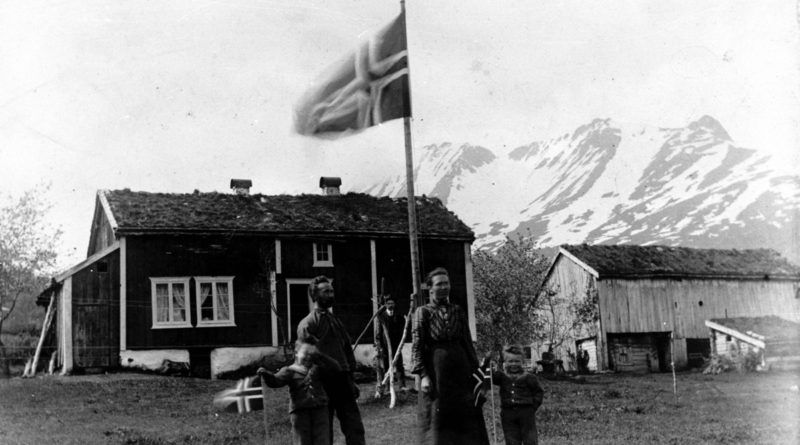


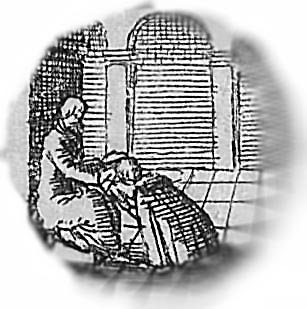
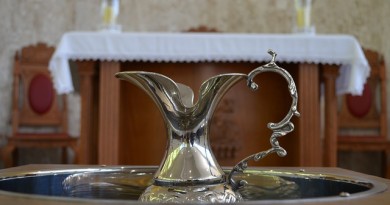
Great article. Many of the places where my ancestors lived had a reference to “bnr.” Now I know what that means.
Thanks Gary!
Very helpful; thanks for the information!
Thanks for you kind words Beth!
This is an amazing piece of writing, Martin. Admittedly, I am still trying to digest it all and relate it to the farm on Sekken.
Thanks Kay. I truly appreciate your feedback!
Great article Martin, as always!
Thanks Joyce! Your feedback is an inspiration.
Great article, I learned a lot, will need to read again to absorb all this wonderful information.
Thanks for your kind words Barbara!
Thank you for this clear and concise article, and for the links.
Thanks for your kind words!
I have been struggling to assess the significance of the changing løpenummer on an ancestral farm. Thank you! This article really clarifies the system!
Thanks for visiting my blog Lisa. I am glad to be of help.
I like Kay am trying to digest all I have read. Sir can you perhaps write an article of how land may be surveyed. Here a towns. The township my grandparents lived in as I investigated was on section 7 of 36 equal sections each section is 1 square mile and at times were split several times similar to the way you have explained in this article. If you have any questions about this I will try my best to investigate and answer the best I can.
Hello John
Thanks for visiting ang for commenting. Could you be a little more specific about”how the land is surveyed”.
I really enjoyed your article, can you explain what the three columns after the the name of the bruk owner signify in the 1866 Matrikkelgard?
Hello Mark
Thanks for visiting. I assume you mean the 1886 Cadastral. The three columns are “Skyld i Mark”, “Skyld i “Daler-Ort-Skilling” and “Remarks”. The two first refers to the value of the farm value in the old monetary units. This was probably used as reference as Norway in 1875 had converted to the unit “Krone-Øre” as we use today.
The “remark” column is in this case used to explain how the farm name is normally written and what name is normally used in everyday speech.
Hope this answers your question Mark
Martin, the timing of this fantastic article is so perfect for me. I teach Norwegian genealogy research and have several new members. Our next meeting is going to be about the bygdebok and it’s structure (and variations) as well as finding their own farms. The following months, I will be getting into the tax and land records and the numbering system will be so important to know. Your article explains this so well. Thank you. I have sent a link to this article to my class members to study before our February meeting.
Hello Linda
Thanks for visiting and for your kind words.
Now tax records can be a challenge 🙂 I have been thinking of writing something about.
Martin